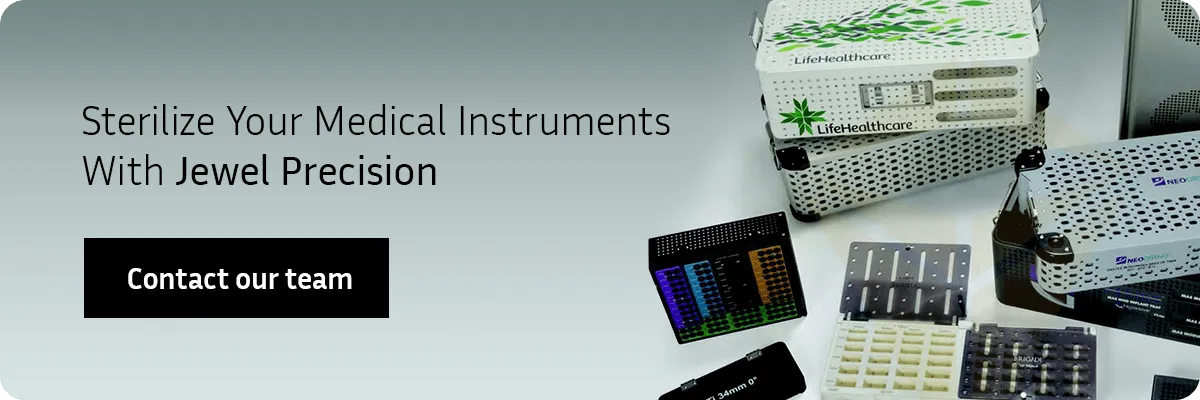
Table Of Contents:
- How To Sterilize Medical Instruments
- Is Autoclaving The Best Sterilization Method?
- Alternate Medical Instrument Sterilization Techniques
- How To Pick Medical Sterilization Equipment
- Sterilize Your Medical Instruments With Jewel Precision
Many medical instruments are reusable, allowing health providers to perform procedures on numerous patients. However, safely reusing these devices requires thorough cleaning and sterilization to prevent cross-contamination and the spread of illness. Instrument sterilization is one of the most critical processes in hospitals, labs and other medical facilities. From surgical instruments to lab dishes, medical devices must be sterile before each use.
How to Sterilize Medical Instruments
Cleaning reusable medical instruments is a more in-depth process than you may think. Sterilization is the third and final step. Before sterilizing equipment, workers must remove all traces of the previous patient. The complete sterilization process is as follows.
- Point-of-use cleaning: First, medical staff will complete point-of-use cleaning, typically immediately after using an instrument, with distilled water or enzymatic cleaners.
- Decontamination: Next, technicians scrub the instruments by hand, then run them through a disinfector washer. They inspect the equipment to ensure everything is clean and functional.
- Sterilization: After point-of-use cleaning and decontamination, the instruments are ready for sterilization. This final step kills any invisible microorganisms that could infect patients or damage equipment if left untreated.
Is Autoclaving the Best Sterilization Method?
Autoclaving, also known as steam sterilization, is one of the best medical instrument sterilization techniques. Autoclaving is the most widely used sterilization method because it is affordable and efficient. Additionally, the process is safe and effective for most medical instruments and devices.
Many medical facilities like hospitals and labs rely on steam sterilization. Steel autoclave chambers are available in various sizes and configurations to accommodate different spaces and equipment types. You can organize medical instruments in secure cases designed to withstand harsh sterilization. Inside the chamber, steam circulates at high temperatures and pressure, destroying microorganisms. The autoclave sterilization cycle is brief, allowing instruments to quickly return to the rotation for future use.
Some medical devices and equipment aren’t eligible for autoclaving. In these cases, other sterilization methods are necessary.
Alternate Medical Instrument Sterilization Techniques
Health care workers may need to sterilize moisture- or heat-sensitive equipment using vapor hydrogen peroxide or ethylene oxide. Tools requiring these approaches typically include any devices or instruments containing explosive or flammable materials, acids, chlorine-based products or radioactive, reactive, toxic or corrosive materials.
What Is Vapor Hydrogen Peroxide Sterilization?
Vapor hydrogen peroxide sterilization is a common method for low-temperature sterilization. This method involves blasting hydrogen peroxide vapor into an enclosure to create a sterile concentration that removes microorganisms from medical equipment. Then, reversing the process breaks the hydrogen peroxide down into water and oxygen to prevent safety concerns associated with hydrogen peroxide residue. Some versions of vapor hydrogen peroxide sterilization may use plasma or ozone to help destroy residual hydrogen peroxide.
Since vapor hydrogen peroxide sterilizes at low temperatures, this method works best for heat-sensitive materials. However, vapor hydrogen peroxide sterilization chambers are often smaller than autoclaves or other sterilization chambers, limiting the volume of your batches. Many of these devices also have load or device limitations, so you must ensure your instruments are compatible with the device you’re using. There are also strict guidelines for staff and patient exposure to hydrogen peroxide to consider at all times.
What Is Ethylene Oxide Sterilization?
In gas form, ethylene oxide is a chemical that can kill bacteria and other microorganisms on medical instruments. This method is becoming increasingly rare, as it’s much less efficient and more expensive than other techniques and presents potential hazards for patients and staff.
How to Pick Medical Sterilization Equipment
Sterilization is an essential process in nearly all medical environments. So how do you know which methods best suit your needs? Here are some considerations to make when choosing medical sterilization equipment for your facility.
- Sterilization needs: Since it’s impractical to steam-sterilize some medical devices, think about what your facility needs to sterilize. It’s possible to autoclave most medical equipment, including surgical instruments, glassware, pipette tips and hospital linens. Because an autoclave can sterilize a wide range of instruments, it’s a top choice for many facilities. Consider alternative sterilization methods for more sensitive materials or unique needs.
- Organization: When considering your medical sterilization equipment options, think about how you’ll organize your instruments in the sterilization chamber. If you throw medical instruments into the chamber haphazardly, it will be time-consuming to sort them later, so it’s best to stay organized from the start. For example, sterilization cases offer practical instrument storage and organization and are autoclave-compatible. Some sterilization methods are challenging to organize instruments in, so autoclave sterilization cases can be extremely beneficial.
- Available space: Don’t forget to account for how much room you have for sterilization equipment in your facility. This assessment can help you determine the chamber size you need and what capacity you can get. For example, you may look for benchtop sterilizers if you have limited space. If you have available floor space, you can get a sterilization chamber with more capacity.
Sterilize Your Medical Instruments With Jewel Precision

If you use autoclave sterilization methods or plan to, be sure to organize and secure your instruments with sterilization trays and cases from Jewel Precision. We design and manufacture durable autoclave cases that withstand harsh sterilization conditions while still allowing your equipment to get fully clean and sterilized. With optimal ventilation, customization capabilities and marketability, you’ll benefit from our products in numerous ways. We offer competitive prices and impeccable customer service to deliver high-quality sterilization products.
To learn more about our products and how we can help you customize your cases, contact our team today.
